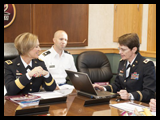
Army Surgeon General Lt. Gen. Patricia D. Horoho, left, speaks with Col. Deborah Whitmer, commander of the U.S. Army Research Institute of Environmental Medicine, during a Sept. 23 visit to USARIEM.
|
NATICK, Mass. (Sept. 25, 2013) -- During a Sept. 23 visit to the U.S. Army Research Institute of Environmental Medicine, the Army surgeon general and commanding general of the U.S. Army Medical Command learned more about the important work being done here for service members.
Lt. Gen. Patricia D. Horoho toured USARIEM, which is situated at Natick Soldier Systems Center, and received briefings on such subjects as biophysics and biomedical modeling, thermal and mountain medicine, military performance, military nutrition, and the development of gender-neutral physical standards for Army Military Occupational Specialties.
"I think what impressed me the most was the level of dedicated scientists, researchers, those that can connect the expertise of what needs to be done in our military with the science behind it so that the right decisions are being made," Horoho said.
Horoho came away impressed by "just how pervasive they are in so many different areas that are tied to our strategic objectives -- whether it is health, whether it's injury prevention, and the performance of our Soldiers, Sailors, Airmen and Marines -- so we are constantly looking at improving the performance of those that are willing to give so much to our nation."
Horoho also spoke about her personal experience with the new female body armor, developed in a collaborative effort between Natick Soldier Research, Development and Engineering Center and Program Executive Office Soldier.
"When I first put it on, the initial impression was … this is what security feels like," Horoho recalled. "And then I had the honor of being able to deploy with it in Afghanistan.
"It was easy to put on, to take off, and more important, it gives you the confidence that you need in an environment that is hostile."
At a time when the body armor is being widely issued to female Soldiers, Horoho talked about how its effectiveness should be evaluated.
"What I think we need to do now, because there was so much research and time and expertise that was put into the (improved outer tactical vest), is we need to have it deployed, really utilized, get the feedback from our females, and then make those adjustments, as needed," Horoho said. "But from an initial use of it? It's pretty much on the mark. So I think it's going to be some small changes, if changes occur with it."
Finally, Horoho addressed Natick's importance during a time of conflict for this nation.
"You know, when we look at the success that we've had on the battlefield for the last 12 years, I think it's because we've had questions that were asked 15 to 20 years ago (and) research that was done here that drove the changes in personal protective equipment or practices," Horoho said. "We need to continue to focus on that to ensure that we're ready for the next 10 to 15 years in the future.
"But I could not be more proud of the team that's here, the hard work and the expertise that we have. We're making a difference."
Learn more at Army.mil
|